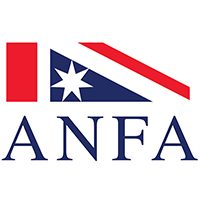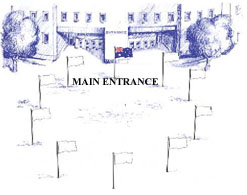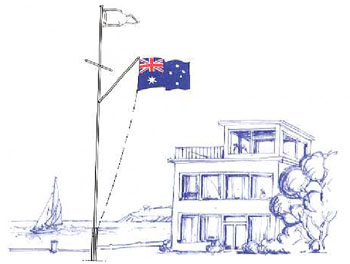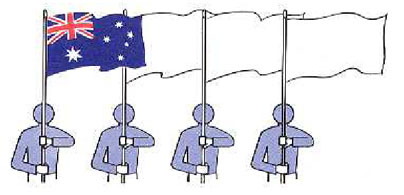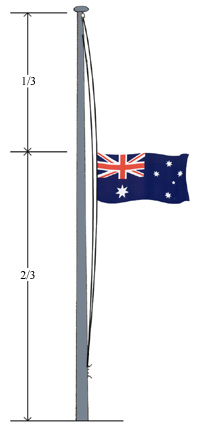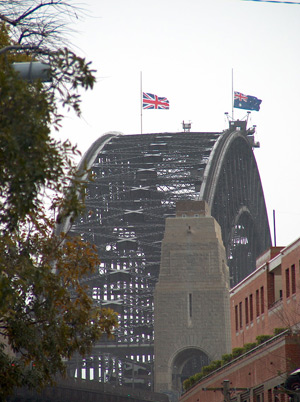Guidelines for Flying Flags
These guidelines apply to the flying of the Australian National Flag and the Australian Red Ensign as well as the use of flags on aircraft, ships and other sea-going craft. The guidelines are also observed by the Defence Forces except for some minor variations to accord with Service traditions or requirements.
The Australian National Flag is the correct flag to be flown on land by individuals, public, private and commercial organisations. It may also be flown on government ships, fishing vessels, pleasure craft and small craft by virtue of section 30 of the Shipping Registration Act 1981.
The Australian Red Ensign is the proper flag to be flown by Australian registered ships. As an alternative to the Australian National Flag, it may also be flown by government ships, fishing vessels, pleasure craft and small craft.
No ship may fly both the Australian National Flag and the Australian Red Ensign simultaneously.
Dignity of the Flag
The Australian National Flag should be displayed only in a manner befitting the national emblem. It should not be subjected to indignity or displayed in a position inferior to any other flag or ensign. The Flag normally takes precedence over all other national flags when flown in Australia. It should always be flown aloft and free and should not be allowed to fall or lie upon the ground.
The Australian National Flag should not be used as a covering of a statue, monument or plaque for an unveiling ceremony (a plain cover should be used); as a table or seat cover, or as a masking for boxes, barriers or intervening space between floor and ground level on a dias or platform.
When the Australian National Flag is raised or lowered, or when it is carried past in a parade or review, all present should face the Flag, men should remove their hats and all should remain silent. Those in uniform should salute.
Defacement
A flag is said to be ‘defaced’ when a ‘badge of office’ or any other object is superimposed upon an authorised flag. Convention is not to deface the Australian National Flag.
Use for Advertising or Commercial Purposes
The National Flag and representations of it should always be shown, represented, or used in a dignified manner. It should not be defaced by way of printing or illustrations, or masked by other objects, and all symbolic parts of the Flag should be identifiable.
Display of the Flag
The Australian National Flag should be displayed as follows:
Flag against a surface whether horizontally of vertically:
The top left quater should be placed uppermost on the observer’s left, as viewed from the front.
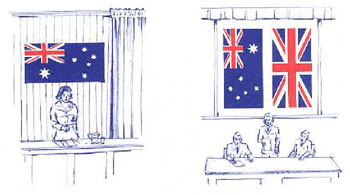 On a staff:
On a staff:
The top left (first) quarter should be placed in the position nearest the top of the staff. When carried, the flag should be aloft and free.
On a flag rope (halyard):
The top left quarter should be placed uppermost, raised as closely as possible to the top with the flag rope tight.
Suspended vertically in the middle of a street
The top left quarter should face the north in an east-west street, and face east in a north-south street, thus being on the left of the observer facing east or south respectively.
 When used to cover a casket at funerals:
When used to cover a casket at funerals:
The top left quarter should be draped over the left shoulder of the deceased. The flag should be removed before the casket is lowered into the grace or, at a crematorium, after the service. Service head-dress, sword or baton as appropriate, awards or medals and family flowers may be placed on the flag covering the casket.
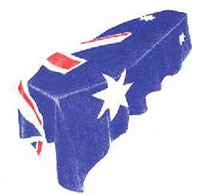 Displayed at night:
Displayed at night:
The flag may be displayed at night, but only when it is properly illuminated.
Position of Honour
Due consideration should be given to flag etiquette and precedence whenever the Australian National Flag or other sovereign nation’s flag are displayed. If a purely decorative effect is desired without the involvement of precedence, it is better to confine the display to flags of lesser status, eg. house flags, or pennants or coloured bunting.
Australian National Flag Flown Alone:
When the Australian National Flag is flown alone on top of, or in front of a building where there are two flagpoles, it should be flown on the flagpole to the left of the observer facing the flag.
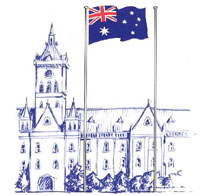 When the Australian National Flag is flown alone on top of, or in front of, a building where there are more than two flagpoles, it should be flown as near as possible to the centre.
When the Australian National Flag is flown alone on top of, or in front of, a building where there are more than two flagpoles, it should be flown as near as possible to the centre.
When the Australian National Flag is displayed alone at a meeting on a speaker’s platform it should be flag against the wall, or on a staff on the speaker’s right as he faces the audience.
Australian National Flag Flown with Flags of Sovereign Nations
The Australian National Flag, when flown or paraded, takes precedence over all other national flags. When flown on separate staffs and at the same height, all being of the same size, with the National Flag occupying the position of honour.
International practice forbids the display of the flag of one nation above that of another in time of peace. The Australian National Flag should, however, be raised first and lowered last, unless the number of flags permits their being raised and lowered simultaneously.
With the flag of one nation, the Australian National Flag should be on the left of the observer facing the flags; both should be at the same height.
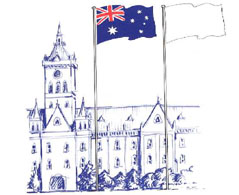 When crossed with a flag of another soverign nation, the Australian National Flag should be on the left of the observer facing the flags; its staff should be in front of the staff of the other flag.
When crossed with a flag of another soverign nation, the Australian National Flag should be on the left of the observer facing the flags; its staff should be in front of the staff of the other flag.
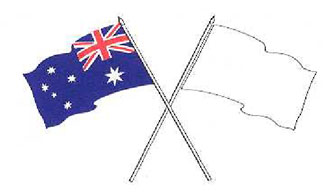 In a line of flags representing a number of sovereign nations, where there are three or more making an odd number of flags, the Australian National Flag should be flown in the centre when only one Australian National Flag is available.
In a line of flags representing a number of sovereign nations, where there are three or more making an odd number of flags, the Australian National Flag should be flown in the centre when only one Australian National Flag is available.
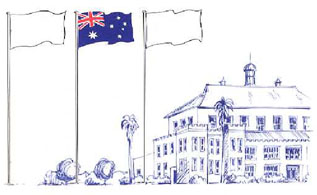 If there are an even number of flags representing a number of sovereign nations, the Australian National Flag should be flown on the left of the observer facing the flags.
If there are an even number of flags representing a number of sovereign nations, the Australian National Flag should be flown on the left of the observer facing the flags.
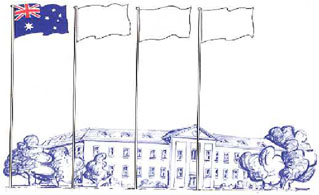 In a semi-circle of flags representing a number of sovereign nations, the Australian Flag should be in the centre.
In a semi-circle of flags representing a number of sovereign nations, the Australian Flag should be in the centre.
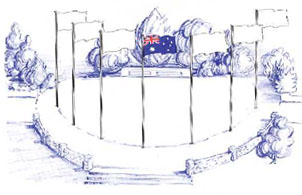 In an enclosed circle of flags representing a number of sovereign nations, the Australian National Flag should be flown on the flagpole immediately opposite the main entrance to a building or arena.
In an enclosed circle of flags representing a number of sovereign nations, the Australian National Flag should be flown on the flagpole immediately opposite the main entrance to a building or arena.
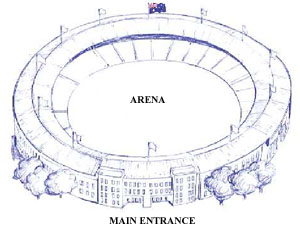 Where two Australian National Flags are available, one should be flown at each end of the line, with the flags representing the sovereign nations in between.
Where two Australian National Flags are available, one should be flown at each end of the line, with the flags representing the sovereign nations in between.
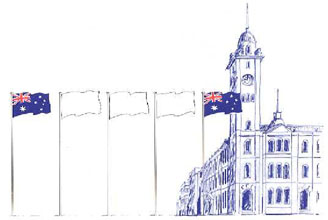 Australian National Flag with State and House Flags
Australian National Flag with State and House Flags
When the National Flag is displayed on, or in front of, a building with Australian State or house flags:
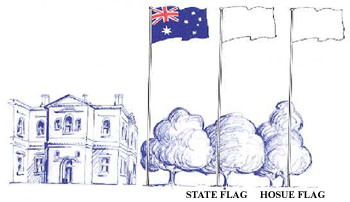 When displayed with State flags, house flags and club pennants, the Australian National Flag should be flown on the left of a person facing the flags, or at each end on a line of flags.
When displayed with State flags, house flags and club pennants, the Australian National Flag should be flown on the left of a person facing the flags, or at each end on a line of flags.
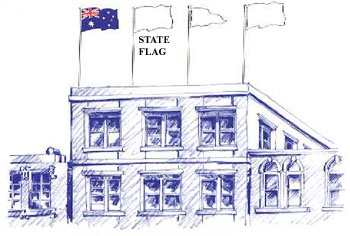 When displayed with State flags, house flags and club pennants on a flagpole fitted with a yardarm, the Australian National Flag is positioned as follows:
When displayed with State flags, house flags and club pennants on a flagpole fitted with a yardarm, the Australian National Flag is positioned as follows:
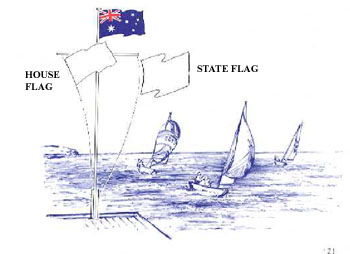 When displayed on a flagpole fitted with a yardarm with a flag of a sovereign nation or a State flag, the Australian National Flag is displayed as follows:
When displayed on a flagpole fitted with a yardarm with a flag of a sovereign nation or a State flag, the Australian National Flag is displayed as follows:
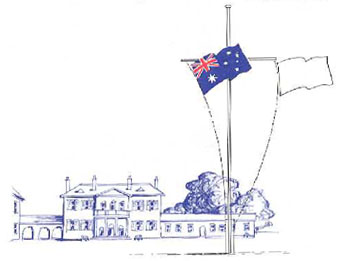 If the flagpole is fitted with a gaff the flag on the gaff has the position of honour, although the national flag is then lower than another flag flying from the peak. This tradition originated in the days of sailing ships and was designed to keep the flag from the ship’s rigging.
If the flagpole is fitted with a gaff the flag on the gaff has the position of honour, although the national flag is then lower than another flag flying from the peak. This tradition originated in the days of sailing ships and was designed to keep the flag from the ship’s rigging.
Australian National Flag Carried in a Procession
If carried with other flags, in a single file, the Australian National Flag should always lead.
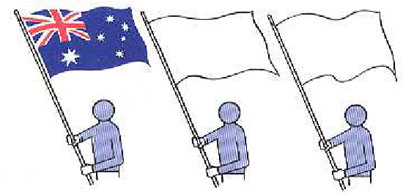 If carried in line abreast, it is preferable to have the Australian National Flag at each end of the line.
If carried in line abreast, it is preferable to have the Australian National Flag at each end of the line.
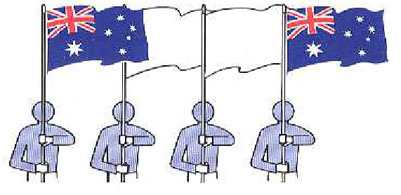 If only one Australian National Flag is available, it should be placed in the centre of the line of flags carried abreast.
If only one Australian National Flag is available, it should be placed in the centre of the line of flags carried abreast.
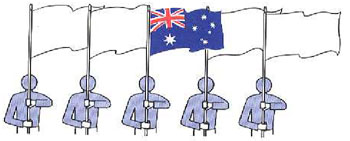 Where the number of flags is even and the Australian National Flag cannot be carried in the centre (of a line of flags abreast) it should be placed (carried) on the right-hand end of the line facing the direction of movement.
Where the number of flags is even and the Australian National Flag cannot be carried in the centre (of a line of flags abreast) it should be placed (carried) on the right-hand end of the line facing the direction of movement.
Flying a Flag at Half Mast
The image below demonstrates the correct method of flying a flag at half mast. The image is courtesy of the Australian Army Ceremonial Manual.
Australian Government Publishing Service.
